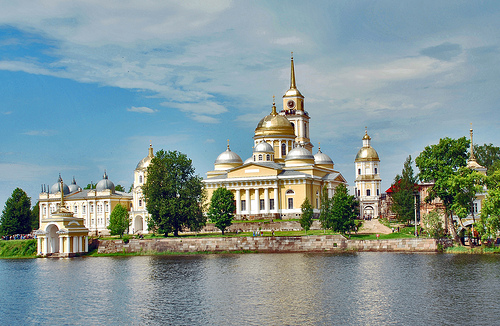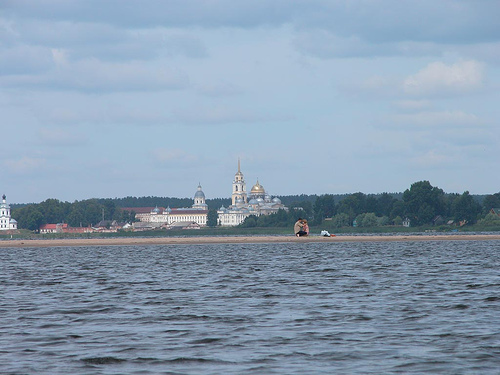

Nilov Monastery (Нило-Столобенская пустынь) is located on the shores of Stolbnyi Island of picturesque lake Seliger in Tver Oblast in Russia. The name of the island literally means "a column".
Location: Stolbnyi Island Lake Seliger Map
Found: 1594
According to some version it describes the overall shape of the island. Another legend claims that this site was used by pagan Slavic tribes for their temple. A column once stood in the centre of this religious complex, giving the name to the island itself. Eventually the temple was abandoned along with the old pagan religions and forgotten. The island was uninhabited until the first Orthodox monk Saint Nilus (Saint Neal) settled here. Eventually more monks have followed him. A small community grew even after death of their original leader. Under leadership of brother German from Monastery of Saint Nicholas Rojok they have found a monastery in 1594. Originally it consisted of wooden structures. Starting from the 17th century the wooden churches and buildings were replaced by stone. The embankment and a causeway was completed in 1812 and large Epiphany cathedral was completed in 1821- 25. Peter and Paul Church was completed in 1764, Church of the Nilus in 1755 and All Saints Church was constructed in 1701. It became one of the largest and wealthiest monasteries in the Russian Empire. It accepted up to 40,000 pilgrims every year. The number of people who lived here reached over 1000 men. After Soviet Revolution everything changed however. In 1919 it was looted by the Bolsheviks. In 1927 it was closed completely and transformed into a commune colony for juvenile delinquents. From 1939- 40 it served as a camp for Polish prisoners of war after Red Army invaded Poland in 1939. In 1941- 45 during years of the World War II it was converted to a military hospital. In 1945- 60 it was transferred to penitentiary system and served as a prison. In 1960- 71 it served a nursing home, and yet again it was transformed into a hostel from 1971 to 1990. After the collapse of Soviet Union the monastery was returned to Russian Orthodox Church. The body of its spiritual leader brother Nilus was returned in 1995.


Actual colored picture made in 1908 (S. Prokudin- Gorsky)
Regarding the name of the island — "Stolobny" or Pillar — there are two versions. According to the first, it got its name because of its shape, similar to a pillar, and according to the second, there was a temple on it in ancient times, and there was a pagan sacrificial pillar.
The Monk Nil Stolobensky was born at the end of the XV century near
Veliky Novgorod. What his name was in the world is now unknown, as well
as who his parents were. It is known that after their death, he went to
the St. John the Theologian Krypetsk Monastery, which is located near
Pskov. There he took vows under the name Neil in honor of the Monk Neil
the Postnik.
In 1515, the Monk Nil left the Krypetsk monastery
and cut down a small cell in the forest in the Rzhevsky district near
the Seremkh River. He lived in seclusion, ate herbs and oak acorns, and
spent all his time in prayer.
According to legend, one day
robbers came to the Monk Nile, who decided to kill him. However, after
making a prayer, he came out to them with an icon of the Most Holy
Theotokos. The robbers imagined that the monk was surrounded by many
armed men. In horror, they fell at his feet, repented and began to ask
for forgiveness.
Gradually, the fame of the hermit spread to the
surrounding villages. People began to come to him, asking for prayers
and guidance. Such a rumor began to weigh on the monk, and 13 years
after settling by the Seremkhi River, in 1528, he moved to a new place —
Stolobny Island on Lake Seliger, seven versts from Ostashkov. For the
first year he lived in a dug-out dugout, then built himself a cell and a
chapel for prayers. According to legend, the devil sent various
misfortunes to the hermit — fires, robber attacks, tried to throw his
cell into the lake. However, the Monk Neil remained adamant, overcoming
all attacks with prayer and faith.
The Monk Neil lived on the
island for 27 years and before his death bequeathed to build a monastery
on this site, which was later done. There is a belief that the Monk Nile
took a vow of non-lying, and therefore was never in a horizontal state.
And he even slept, hanging himself by the shoulders with ropes or on
hooks driven into the wall.
In 1555, Nile passed away and was
buried on Stolobny Island. In 1594, with the permission of Patriarch
Job, a monastic monastery was opened. Thus began the history of the
monastery of the Nilo-Stolobenskaya desert. The founder of the monastery
was Hieromonk Herman.
After the death of St. Nile, hermits began to settle on the island
near his grave, prayer books, and they founded the monastery. Before the
1917 revolution, the Nilo-Stolobensky Monastery was among the most
revered in Russia, thousands of people came here every year. In 1820,
the monastery was visited by Emperor Alexander I. In 1858, a granite
embankment was built around the island.
At the beginning of the
20th century, the number of permanent residents reached 1,000 people,
and the monastery even had its own hospital.
In 1919, all church
valuables were seized, and the relics of St. Neil were opened. The
monastery operated until 1927, and later it underwent several changes.
By the end of the 1980s, a significant part of the buildings had either
been lost or were in a dilapidated state. In different years, there were
in the Nilo-Stolobenskaya desert:
in 1927-1939 — a labor commune, a
colony for juvenile delinquents;
in 1939-1940 — a camp for Polish
prisoners of war;
in 1941-1945 — a hospital;
in 1945-1960 — colony
again;
in 1960-1971 — nursing home;
in 1971-1990 — camp site.
In 1990, the Nilo-Stolobenskaya Desert complex was transferred to
the Russian Orthodox Church. In 1995, the relics of St. Nile were
returned to the monastery.
Epiphany Cathedral. The beginning of construction was in 1671, and
the finishing work was completed in 1833. The silver gates for the
cathedral were cast according to the sketches of Yakov
Kolokolnikov-Voronin. The relics of St. Nile, discovered in 1667 and
returned in 1995, openly rest in the temple. The interior painting is
almost completely lost.
The gate church in the name of the first
Apostles Peter and Paul.
The Holy Cross Church stands apart from the
main monastery complex. Baptismal rites took place in this church, which
are not performed in the main temples of monasteries.
The gate church
in the name of St. Nile.
The church in the name of All Saints, which
was a cathedral until 1833, later a hospital. One of the oldest
buildings of the monastery. Currently, it is almost completely destroyed
and is being restored.
The church in the name of St. John the Baptist
and the Intercession of the Virgin, built on the site of the cave of St.
Nile. In 1939, it was completely destroyed, the bricks went to the dam
connecting the island with the "mainland". Excavations are currently
underway at the site of the temple.
In the museum "The Legacy of St. Nile", located on the territory of the Nilo-Stolobensky desert, there is a statue of "Nile Stolobensky" — a carved and painted sculpture, revered as miraculous. Presumably, it was created in the 1770s-1780s. The sculptural image of the monk was made for the Intercession Church of the Church of John the Baptist of the Nilo-Stolobenskaya desert. Tamara Barseghyan, head of the scientific, methodological and pedagogical work sector of the Andrei Rublev Central Museum of Ancient Russian Culture and Art, Doctor of Art History, suggested that its author could have been a sculptor who worked on the decoration of temples in Ostashkov, the Nilo-Stolobenskaya Desert and the Valaam Monastery Kondraty Semenovich Konyagin.
As of November 2012, there were about 50 inhabitants in the
monastery, about 20 in holy orders.
The monastery has several
farmsteads, including in Torzhok. There are candle, dairy and carpentry
shops in the monastery, there is a cowshed, a stable, an apiary, and you
can buy consecrated honey in the church shop. The monastery has its own
jewelry workshop (revived craft). The monastery conducts trade at
Orthodox fairs in Moscow. There is a hotel for pilgrims in the
monastery.